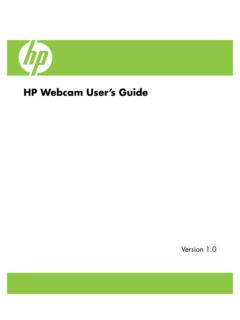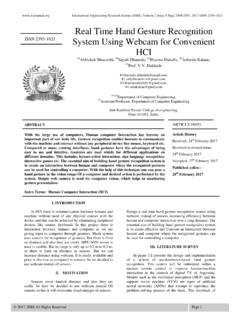Transcription of Long Exposure Webcams and Image Stacking Techniques …
1 Long Exposure Webcams and Image Stacking TechniquesKeith Wiley and Steve : M27, Dumbbell Nebula. Captured with an SC3 color Vesta and an SC3 B&W Vesta by Carsten Arnholm with a C8 scope and a Mogg .6 FR. 65x40sec color, 40x40sec B&W. K3 CCDT ools, Registax2, In recent years a new method for astrophotography has emerged which uses very affordable equipment and produces competitive results. Standard Webcams , originally created for the consumer-oriented video-conferencing and cheap home-based photography markets, have turned out to be an excellent source of affordable astrophotography cameras. These cameras often cost between $50 and $150 dollars, and even after the modification described below, are still highly affordable compared to the astrophotography-oriented CCD cameras available from mainstream imaging can be performed with the right Webcams without any modification and you can start immediately if that is your interest.
2 For deep sky imaging, Webcams out of the box suffer from several problems, most of which can be minimized or eliminated. Astronomical Cameras and WebcamsThe first mass produced webcam , the black and white Quickcam made by Connectix, shared many similarities with a dedicated astronomical CCD cameras in production at the same time, including the type of CCD used and the control method which used the computers printer connector to directly control the sensor. Sadly the software that was supplied with the webcam had a bug which prevented the camera taking long exposures required for deep sky imaging. Dave Allmon started the first wave of interest in deep sky webcam imaging by writing a control program for this web camera that allowed long exposures and the imaging of faint objects. Dave s first deep sky images were of the Andromeda galaxy with many fainter objects such as the Horse Head nebula soon following.
3 From this starting point developments in Webcams and astronomical CCD cameras have driven these products in very different directions. Astronomical CCD cameras have maintained a relatively high price and have aimed for precise digitisation of the signal from each pixels of the CCD at the expense of Image download time. Webcams have strived to achieve high frames rates of brightly lit subjects from color CCD s, quite often at the expense of Image quality. In order to use modern Webcams for deep sky imaging we need to address a number of issues including Exposure time and Image quality. The solutions are a combination of hardware and software modifications, and specialised Image processing techniquesModified CamerasThe specific details of the modifications are best gained from the websites given in table 1. Here we will only cover in subject in broad terms. Also bear in mind that astronomical cameras based on these designs are available commercially if soldering to surface mount components is not one of your skills.
4 The first stage is acquiring a suitable webcam . While this sounds trivial time spent researching the best Webcams for modification will be very worthwhile. At the time of writing the Philips ToUCam II Pro is regarded as the best with the Logitech Quick Cam Pro 4000 and Creatives ex Pro also worthy. All these cameras feature CCD sensors rather than CMOS devices. While some digital camera CMOS chips have been found to be very capable of astro imaging those currently used in Webcams have invariably low sensitivity. This might change in the future so its worth checking web sources such as QCUIAG to find the currently favored 1. Websites with background information on long Exposure modified : SC modded ToUcam, by Ashley : Cooled SC modded ToUcam, by Ashley : modded Vesta, by Keith modification the cameras are limited to relatively bright objects such as the moon and major planets.
5 This lack of sensitivity is not due to inherent limitation in the CCDs used in the Webcams . Indeed the quantum efficiency of the best webcam CCDs is on a par with dedicated astro cameras. The sensitivity problem is linked to the Webcams producing a moving Image consisting of at least 5 frames per second. To Image deep sky objects we really need to take picture with exposures of 30 seconds or more rather than the seconds offered by the standard webcam . So the solution developed by the authors was to place some of the Webcams internal timing directly under the control of the PC. The electronic circuits needed to achieve this are very simple but the working on the surface mount components requires some skill and experience with a soldering iron. Good advice if you are considering going this work yourself is to find a scrap circuit board with some surface mounted chips to practice on.
6 As the specifics of the modifications vary from camera to camera these are best referenced from the Internet. Once modified, the Webcams exposures can be controlled to be any length the user likes by using software that is compatible with these 2 by Phil by Martin Ex Pro by Jack of webcam modification sitesTable 2. Sites giving camera specific modification details. The modification to control length of Exposure is fundamental to adapting Webcams for deep sky use. In addition to this, other modifications to the camera s hardware is optional though can be beneficial. The CCDs used in the Webcams feature on chip amplification circuitry. This significantly increases the quality of the images produced as it keeps the amount to electrical noise added to the imaging to a minimum. However this amplifier also emits photons by a process termed electroluminance.
7 In exposures lasting 30 seconds or more this results in an objectionable glow in a corner of an Image corresponding to the part of the CCD array closest to this circuit. A solution is to drop the voltage to this circuit while the CCD is collecting its Image and then to restore it when its needed while the Image is read out of the CCD. This modification is known slightly confusingly as the amp off or amp switch modification. Also possible although not particularly popular is a modification to the Webcams that allows half the CCD to be read out at a different speed to the rest of the array. This is can be useful to simultaneously guide a telescope using exposures of one second or so while the main Image is built up for a minute or two. The CCD based Webcams tend to use 1/4 inch color CCDs. The color information is gained from tiny red green blue filters that are place on top of the CCD structure.
8 The arrangement is in blocks of 4 pixels each having 2 green and 1 red and 1 blue filter. This allows the webcam to take a full color Image without requiring external filters but as the filters only let though a single color the sensitively is significantly reduced. Recently amateur astronomers have successfully replaced the standard CCD by unfiltered black and white versions. Also it is possible to swap the standard 1/4 inch CCD for something rather larger like a 1/3 or even a 1/2 inch CCD. When bought is small quantities CCD chips can be quite expensive so a 1/2 inch CCD will probably cost more than the camera it is going into. However, as the light gathered is proportional to the surface area of the sensor, these chip swaps can be very worthwhile. of 1/4 inch B/W CCD. Etienne inch CCD. Steve inch CCD. Greg BeekeTable 3. Websites detailing CCD replacement final stage of hardware modifying a webcam is often building a new case for it.
9 While it is possible to fit a modified webcam back in its original box there are advantages to using a bigger box that allows for better air circulation and allows some cooling. When a webcam is left running it consumes electrical power and produces some heat which if left to build up in the cameras case will raise the CCD temperature and increase the thermal noise its produces. Simply allowing air to circulate and take away this heat is surprisingly effective especially on a cold night. For greater cooling Peltier coolers are able to reduce chip temperatures to 40 degrees or more below ambient. This does generate a whole new set of problems in stopping the chip from dewing or even icing up. The standard lens in a webcam typically has a focal length of 7mm and a focal ratio of about 3. This is idea for capturing whole constellation pictures maybe including some foreground subject.
10 To move onto specific deep sky objects a method for coupling the camera to a telescope is required. Probably the most versatile method is to incorporate a camera macro extension ring into the box design as this will allow both focuser adaptors to be used for prime focus telescope imaging and also camera lenses could be employed to give wide angle shots. Figure : M16, Eagle Nebula. Captured with an Vesta by Keith Wiley with a Meade 8 LX200 and Mogg .6 FR. 44x90sec. Keith s Image Stacker, Photoshop modifying the webcam hardware for use in deep sky imaging is also possible to change the setting for the camera to make the best use of these alterations. The standard drivers for Webcams tend to concentrate on producing the best high frame rate images of brightly lit subjects by using high compression and artificially emphasising edges in images to give the appearance of sharpness.









